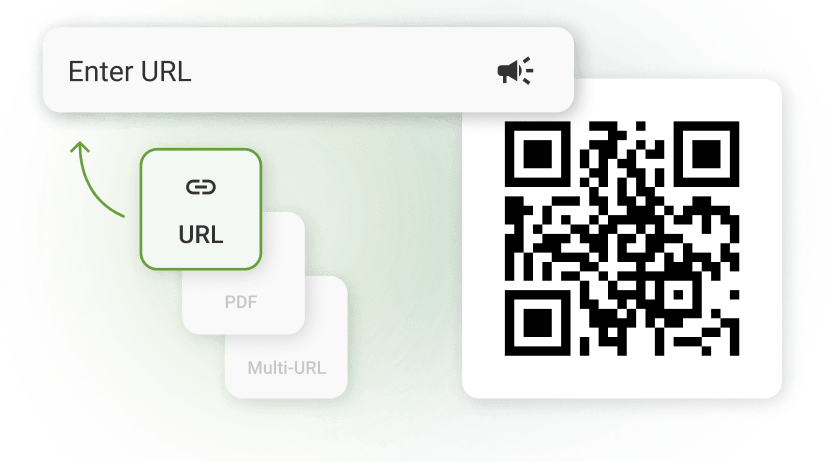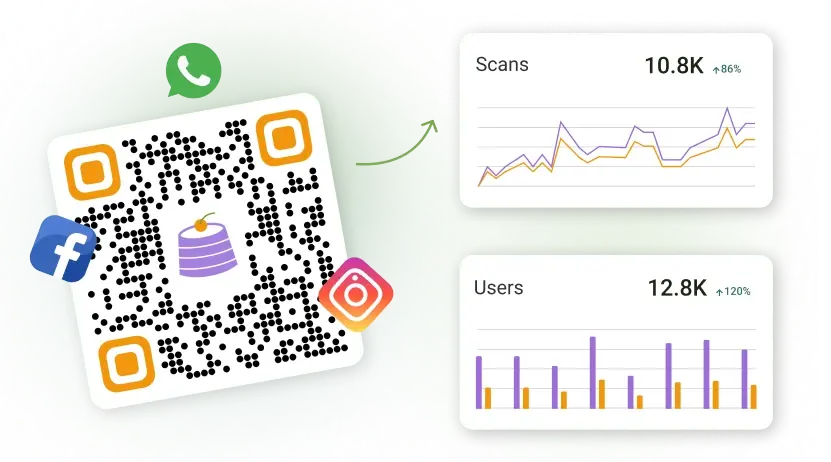Did you know that increasing customer retention rates by just 5% can boost restaurant profits by 25% to 95%?
Yet, many restaurants struggle to turn first-time diners into loyal, repeat customers.
The problem is that signing people up for your loyalty program during checkout is tough. Your staff is preoccupied, and guests are ready to leave.
A more strategic solution? Add a QR Code directly onto the receipt. With a compelling incentive, it captures their attention in the moment when their experience is still top of mind.
Let’s explore how this simple change can make a big difference, starting with what might be holding your current loyalty program back.
Table of contents
- Why your restaurant’s loyalty program is not getting repeat customers
- Restaurant receipt QR Code strategies to boost loyalty
- Steps to create QR Codes for receipt-based loyalty campaigns
- Best practices to optimize your restaurant receipts with QR Codes
- Make strategic choices to turn receipts into loyalty revenue
- Frequently asked questions
Why your restaurant’s loyalty program is not getting repeat customers
Many restaurants miss out on loyalty signups simply because they don’t ask at the right time. Guests are busy, staff are rushed, and there’s no real moment to discuss the program. The chance to turn a one-time guest into a regular walks out the door just like that.
These are the clear, common roadblocks that keep loyalty programs underused:
1. Missed post-dining engagement opportunities
The first opportunity for restaurants would be to get an opt-in at the register. But, most guests are ready to head out as soon as they pay, especially during busy hours or at self-checkout kiosks. Staff rarely get to ask for an email ID or explain the perks of joining a rewards program while managing other customers. This means many guests, even the ones who enjoyed their meal, leave without joining.
The second opportunity is right after they’ve left. Unless someone’s already signed up, there’s rarely a follow-up. And let’s face it, most diners won’t visit your website later just to find your loyalty program. Without a quick, well-timed nudge, the moment is lost.
2. Absence of personalization
Another reason your restaurant’s loyalty program might be failing is that it’s not personal enough. If every guest is treated to the same rewards, duplicate emails, and the same offers, they don’t feel special.
Today’s diners expect experiences tailored to them. If your regular customer who always orders the restaurant’s signature dish isn’t getting rewards that reflect their preferences, they’ll stop paying attention.
A one-size-fits-all approach makes your program easy to ignore and harder for guests to stay loyal.
3. Lack of incentive or visibility
People need to know clearly that the loyalty program exists to sign up for it, but many restaurants hide these offers where customers never look, tucked away inside an app or buried on a website.
Also, guests will simply move on if there is no obvious reward, such as a small discount or a free add-on for next time, and the loyalty program will remain unnoticed.
Adding QR Codes to receipts gives customers a simple, in-the-moment way to join your loyalty program, and helps turn a great experience into a repeat visit.
Restaurant receipt QR Code strategies to boost loyalty
QR Codes on receipts make it simple for guests to sign up, earn rewards, and stay connected with your restaurant. Many well-known restaurants already use this strategy to build loyalty, which works just as well for smaller businesses looking to keep customers coming back.

Here are some strategies you can get started with:
1. Simplify loyalty program enrollment
Your diners are more likely to join your loyalty program if you make scanning a QR Code on the receipt effortless. The code can take them to a mobile-friendly sign-up page where they can enroll in seconds and often receive a first-visit reward such as a discount on their next meal.
This method works because it reaches customers at the perfect moment, right after a good dining experience. Guests can join without waiting for a server to explain the program or interrupting their exit.
Example: A casual burger joint places a QR Code at the bottom of each receipt. When scanned, it opens a short sign-up form offering guests 10% off their next visit. Another family-style restaurant links its receipt QR Code to a digital loyalty program where customers earn points for every dollar spent, starting with a free dessert on their next visit.
2. Deliver personalized rewards instantly
When guests scan a QR Code on the restaurant receipt, they can receive a personalized reward tied to their visit, such as a free drink, a small discount, or loyalty points for their next order. This gives customers a clear reason to return and shows them you value their visit.
Example: A family-style grill has unique QR Codes on each receipt, linking to offers based on visit data. For example, larger checks may unlock a higher-value reward, while returning guests get loyalty bonuses tied to past visits.
3. Collect first-party data for targeted marketing
A QR Code on the receipt can help collect valuable customer data, such as emails or phone numbers, during the scan. With this data, you can send personalized offers and promotions that bring customers back for another visit.
This approach helps you build a direct relationship with your customers, letting you run targeted campaigns that encourage repeat visits and increase customer lifetime value.
Example: Prevalent in the US, restaurants using Toast POS gather customer contact details through QR Codes on receipts. This allows restaurants to follow up with personalized offers and updates.
4. Run a referral campaign using QR Codes
QR Codes on restaurant receipts can power low-effort, high-impact referral campaigns. After paying, guests can scan the QR Code on their receipt to access a unique referral link or code. They can share it with friends, and when someone uses it to make a qualifying purchase, both the referrer and the new customer receive a reward, such as a discount or a free menu item.
Example: A fast-casual pizza place prints a QR Code on each receipt that links to a customer’s personalized referral page. Guests can scan and instantly share their link via text or social media. When a friend places their first order worth $15 or more, both the referrer and the friend receive a free side or $5 off their next visit, encouraging repeat visits and word-of-mouth growth.
Steps to create QR Codes for receipt-based loyalty campaigns

You cannot just add a QR Code at the bottom of your receipts and hope people will scan it. You must set up each QR Code with clear goals, smooth design, and customer-friendly flows for guests to engage with them.
When you plan your QR Code strategy well, you can convert a simple receipt into a gateway for sign-ups, repeat visits, and a meaningful guest experience. Here are some steps to help you set up QR Codes on your receipts so they work for your loyalty campaigns.
Step 1: Start with a clear goal
Before generating your QR Code, consider what you want it to achieve.
Are you looking to get more loyalty program sign-ups, encourage repeat visits with discounts, or invite customers to refer friends or download your app?
This clarity will help you decide what page your QR Code will lead to, what call to action you’ll print, and how to measure success.
Tip: If your goal is to increase sign-ups, link your QR Code to a short, clean sign-up page instead of a generic website. This small step alone can improve conversions by reducing clicks and confusion.
Here’s a table to help you match your goal to the right QR Code campaign on receipts:
| Your goal | QR Code leads to | Suggested campaign type | Pro tip |
| Increase loyalty sign ups | Loyalty program sign-up page | “Join & Earn” QR Code | Keep the form short and mobile-friendly for faster conversions. |
| Drive repeat visits | Discount or reward coupon page | “Scan for 10% off your next meal” | Add an expiry date to create urgency. |
| Encourage social sharing/referrals | Referral program landing page | “Invite friends, get rewards” | Include clear steps and an incentive to refer right away. |
| Promote daily/weekly specials | Dynamic menu or daily special page | “Today’s Chef’s Special” | Use dynamic QR Codes so you can update content without reprinting anything. |
Step 2: Use dynamic QR Codes for flexibility
With a dynamic QR Code generator, you can change your landing page without reprinting receipts. You can also track how many people scan it, see when and where scans happen, and test which incentives bring the most customers back.
In contrast, static QR Codes limit you to one URL forever, which is risky if you want to update your offers.
A dynamic QR Code also makes A/B testing easier. Try “10% off next visit” versus “Free dessert” to see which reward drives more visits.
Restaurants using The QR Code Generator (TQRCG)’s dynamic option can conveniently manage campaigns, tweak offers, and monitor performance in one place. This approach turns QR Codes from a one-time tool into a living, flexible part of your marketing strategy.
It’s easy to generate a dynamic QR Code in just a few clicks. Plus, with every scan fully trackable, you will know what’s working and what’s not.
Try The QR Code Generator (TQRCG) now!
Step 3: Design for receipt printer compatibility
Thermal receipt printers can only handle black-and-white designs, and print quality varies. Here are some things to keep in mind while printing your QR Codes on the receipt:
- Avoid gradients or fine logos; stick to clear black-and-white patterns.
- Leave ample white space around the code for scanner clarity.
- Use a minimum size of 1 × 1 inch for reliable scanning.
- Export at a high resolution like 300 DPI, for sharp edges, ensuring readability even on faded paper.
- Test by printing and scanning your QR Code design before launch to prevent customer frustration.
Step 4: Place your QR Code where customers will see it
Your QR Code won’t matter if customers don’t notice it. Place it near the bottom of the receipt, close to the thank you message or the total, where customers naturally look. Your call to action must be clear, benefit-driven, and printed directly above the QR Code.
For example:
- “Scan to unlock your next reward.”
- “Join our loyalty club in 10 seconds. No app needed.”
- “Scan to get your free dessert.”
These clear CTAs work better than a generic “Scan me” because they tell customers exactly what they will gain.
Step 5: Link to a mobile-friendly, fast-loading page
Once customers scan the QR Code, they must land on a page that works smoothly on mobile.
Keep it simple by asking only for their name, email, or phone number and offering one-tap log in using Google or Apple. Avoid long forms. If you’re offering a reward, show it immediately after they sign up to create instant excitement.
Step 6: Track your results and optimize

Your QR Code strategy must give you insights, not just scans. Consider adding UTM tracking or embedding receipt data into your QR Code URL to trace which scans lead to sign ups and redemptions. This data helps you identify what’s working, refine your offers, and see which campaigns truly drive repeat visits.
TQRCG’s dynamic and trackable QR Codes come with free analytics tools that provide per-day scan data, user information, location, devices, and scan timings. You can dig into these metrics on the dashboard and understand:
- When people scan: Spot peak hours and adjust your offers
- Where they scan: See which locations or cities respond best
- What device did they use: iPhone or Android? Desktop? Tailor the landing page accordingly
- What action did they take: Add UTM tracking to know if they signed up, clicked, or redeemed a reward
So now we know that QR Codes on restaurant receipts are as good as your campaign goals, design, and strategy. But what would make a QR Code really stand out, and how would you evaluate it? Let’s find out.
Best practices to optimize your restaurant receipts with QR Codes
Small details such as design, placement, and tracking can distinguish a QR Code that actively brings customers back from one that gets ignored.
Here are some tried-and-true methods to help you make the best use of QR Codes in your restaurant.
- A/B test offers to see what works: Rotate incentives such as discounts or free add-ons using dynamic QR Code links and see which ones bring customers back more often. Compare scan and redemption rates to tailor offers by location, time of day, or customer type.
- Incentivize the first scan: Give customers a small, immediate reward such as 10% off or a free side to encourage them to scan your QR Code. You can also add a fun element with digital scratch cards or mystery offers to create excitement.
- Train staff to mention the QR Code reward: A quick reminder from your cashier or server, such as “You can scan this for a discount next time,” can nudge customers to take action. Many guests overlook receipts, so a verbal prompt often boosts scan rates.
- Refresh offers regularly: Customers will stop scanning if the incentive never changes. Rotate offers seasonally or tie them to specific dishes or events to keep the QR Code experience fresh and engaging.
- Test scan reliability on different devices: Before launching, test your receipt QR Codes on a range of devices (iPhone, Android, older models) to ensure they scan under different lighting conditions and angles.
- Comply with data privacy laws: If your QR Code collects customer data, follow local privacy laws, such as the EU’s GDPR and India’s DPDP Act. Clearly state how you will use customer information on the landing page.
Make strategic choices to turn receipts into loyalty revenue
Most restaurants see receipts as transactions, but the forward-thinking ones see them as a gateway to the next visit. A simple QR Code can transform that thin slip of paper into a tool that builds loyalty, collects valuable customer data, and keeps your tables occupied
And when you design your QR Code with intention, place it in plain sight of customers. Give people a reason to scan, and you create a smooth, low-effort way to grow repeat visits. It’s a minor tweak with the potential to create a steady stream of returning customers who feel valued and connected to your brand.
The best part? You don’t need heavy tech investments or complex workflows to get started. You just need a clear goal, a well-placed QR Code, and the mindset to turn everyday moments into revenue opportunities.
Ready to turn your receipts into a loyalty machine? Start building your trackable, reward-driven QR Code campaigns with The QR Code Generator (TQRCG) and see your guests return for more.
Frequently asked questions
Yes, you can run different loyalty campaigns using the same printed QR Code. Dynamic QR Codes from The QR Code Generator allow you to change the destination URL anytime so that you can rotate offers such as weekday lunch promos and weekend dinner deals without reprinting receipts.
Small, instant-gratification rewards work best with receipt QR Code campaigns. Offers such as a free dessert, 10% off the next visit, or a scratch-to-win game encourage customers to scan and return. The QR Code Generator lets you link these QR Codes to any reward page or gamified campaign that fits your audience and timing.
You can keep QR Codes readable on thermal receipt paper using high-contrast, black-and-white designs without logos or fine details. The QR Code Generator exports QR Codes in print-ready 300 DPI formats to ensure they scan accurately, even on lower-quality thermal prints.
Yes, you can test multiple offers across different stores or days. By generating separate QR Codes with unique tracking links using The QR Code Generator, you can assign each code to a specific location, time slot, or campaign and monitor which one drives more scans or redemptions.
You can increase scans by printing a bold, benefit-focused call to action directly above the QR Code, such as “Scan for a free treat next time.” The QR Code Generator also lets you add frames with clear messaging to highlight the benefit and encourage customers to scan.
Your QR Code must link to a mobile-optimized web page that loads quickly and asks for minimal information, such as a name and email. You can link it to loyalty sign-ups, referral campaigns, or digital rewards. The QR Code Generator supports all these link types.
Yes, you can include a short URL below the QR Code as a backup for customers who prefer typing over scanning. The QR Code Generator provides a custom short URL that you can print below the QR Code to ensure every guest can view your offer.
You can know if your receipt QR Code campaign works by tracking scans using The QR Code Generator’s built-in analytics. This feature lets you view scan data by day, device, and location, helping you see which campaigns and periods perform best.







